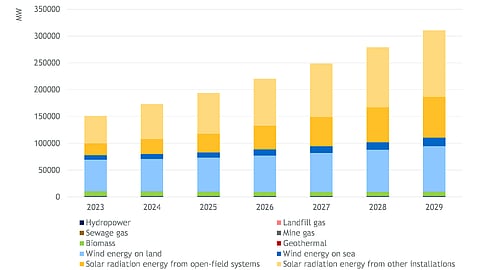

EWI’s new assessment on Germany’s EEG funding expects it to support over 300 GW of new RE capacity by 2029-end
It expects almost €18 billion in funding to be available for 2025, an increase of around €1 billion over 2023
Ground-mounted solar will especially see significant growth due to falling technology costs and supportive regulatory conditions
One of the leading tools of renewable energy growth in Germany, the Erneuerbare-Energien-Gesetz or the Renewable Energy Sources Act (EEG) is likely to support the country’s renewable energy generation capacity to reach more than 300 GW by the end of 2029, according to the Institute of Energy Economics (EWI) at the University of Cologne.
According to the EEG’s medium-term forecast, the EWI expects its funding volume to grow by around €1 billion ($1.08 billion) to almost €18 billion ($19.5 billion) for 2025, compared to 2023. This should lead to the growth in renewable energy installations by 2029. These plants could generate around 380 TWh in 2029, compared to 245 TWh in 2023.
“The EEG subsidy payments could rise to almost EUR 23 billion in the same period – despite the withdrawal of 22 GW of solar and wind energy plants from the EEG subsidy scheme with high remuneration rates by 2029,” according to EWI.
It makes these forecasts in its report titled Medium-term forecast for Germany-wide electricity generation from EEG-funded power plants for the calendar years 2025 to 2029.
This report offers 3 different scenarios for the development of installed capacity, annual energy and subsidy payments for the 2025 to 2029 period. Renewable energy sources covered include wind, solar radiation, hydropower, landfill gas, sewage gas, mine gas, biomass (including biomethane) and geothermal energy.
Under the most probable scenario, the trend scenario assumes strong growth in ground-mounted solar installations that are expected to more than triple by 2029-end, compared to 2023. By 2030, the country officially aims to install 215 GW of solar, expanding the volumes to 400 GW by 2040 (see Germany’s Bundestag Clears Easter Package).
“The main factors for this are falling technology costs and the regulatory framework conditions, which have improved significantly as a result of the Easter and Solar Package I, among other things,” according to the Project Lead and one of the authors of the report Dr. Fabian Arnold. Supportive regulatory conditions are defined as higher subsidy rates, and tender volumes, and easing of permitting procedures.
Nevertheless, the expansion of renewable energy capacity cannot ‘fully compensate for the dismantling of the comparatively old power plant stock of these technologies.’
The EEG funding will also increase due to a projected decline in the expected market values, it adds.
“If the market values of the technologies now fall below this state-guaranteed minimum remuneration, this difference is compensated in the form of EEG payments,” explained the Head of Research Area at the EWI, Dr. Philip Schnaars. “In particular, the market values of solar plants fall in our simulations due to the high simultaneity of their generation. As a result, the subsidy payments via the EEG even increase disproportionately to the expected expansion.”
